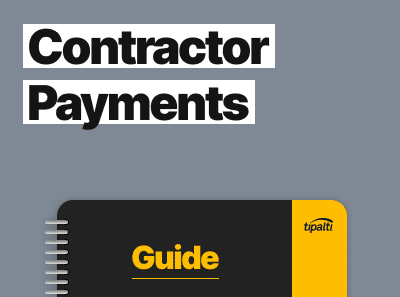
Mastering independent contractor and freelancer payments can be tricky. Is your business equipped to handle it?
Fill out the form to get your free eBook.

More than 50% of US workers are engaged in the gig economy, which is growing rapidly. These contractors are increasingly crucial to your business success in today’s dynamic digital environment.
To compete effectively, brands like yours need to scale contractor payments faster and more efficiently while keeping your contractors happy. A modern, reliable payment process will give your company a competitive advantage in an unpredictable market.
We invite you to read our new eBook, Are You Struggling With Paying Contractors? which reveals why automation is the solution. You’ll learn:
– Four pain points of manual contractor payments
– Five key ways automation improves payment inefficiencies
– How to build a more robust contractor network
Contractor onboarding is the process of initiating work with independent contractors or freelancers, capturing their contract agreements, contact information, IRS-required information, and preferred payment methods in a system, and orienting and training them.
Contractors are a rapidly growing segment of workers who participate in the gig economy rather than serving as employees. Your business needs to consider the pros and cons of hiring in-house employees or outsourcing projects to independent contractors.
A good onboarding process for contractors will help the freelancers understand policies and goals and provide better services to your business. Contractors will gain an understanding of your company, the team members, business systems, and payment processes. Automating contractor onboarding will save time and reduce your company’s onboarding costs.
Why Contractor Onboarding Matters
Contractor onboarding matters because your company needs to establish that a non-employee relationship exists through contractual documentation. Independent contractors and freelancers will begin to work more efficiently and effectively if they understand the company and its policies, procedures, and goals through an orientation session.
By collecting W-9 or W-8 tax forms upfront before the first payment when onboarding contractors, the accounts payable staff will not need to chase down forms required to prepare 1099-NEC information returns near the calendar year-end.
When contractor onboarding details and payment methods are captured early, paying independent contractors won’t be delayed for procedural matters.
What’s Included in the Contractor Onboarding Process?
The contractor onboarding process includes:
- Company, team, and project orientation and applicable system training
- Document repository for contracts and other independent contractor agreements like NDA forms
- Collecting independent contractor information and tax forms in a system
- Communicating payment policies
- Communicating the independent contractor meaning and tax forms
Improve contractor relations with payment method choices and on-time payments
Make independent contractor or freelancer payments more accurate, efficient and timely with guided contractor onboarding, automated invoice processing, and electronic global payments.
The Most Effective Contractor Onboarding Practices
5 effective contractor onboarding practices follow. These cover contractor onboarding processes and contractor management through a system.
#1 – Independent contractor onboarding checklist
Your company’s customized contractor onboarding checklist should include all applicable steps for onboarding its independent contractors and freelancers, including a streamlined contractor onboarding workflow.
Electronic distribution of company policies applicable only to independent contractors should be considered part of the onboarding program orientation process covered in the checklist. The company policies distributed to contractors would be different from those used by the HR team for first-day employee onboarding.
#2 – Immediate contractor information and nonemployee IRS tax form collection
Onboard independent contractors or freelancers to your applicable company systems to gather required information and enable payments. Because independent contractors aren’t employees, they should be paid like suppliers in accounts payable or mass payments, not through an employee payroll system.
Systems that guide independent contractors to enter their own information through a Supplier Hub during the contractor onboarding process are ideal. An effective automation system that handles freelancer payments can require freelancers to digitally submit their W-9 or W-8 form data before the payer makes the first payment.
The system’s independent contractor onboarding can ideally specify the non-employee contractor’s preferred payment method, payment information, and desired currency for the payment.
#3 – Document repository
Businesses need to preserve legal documents, including independent contractor contracts, non-disclosure agreements (NDAs), and intellectual property agreements. When onboarding independent contractors, capture these contractual protection and confidentiality agreements in a centralized electronic document repository. Determine whether a non-compete agreement like those for new employees is appropriate for the type of contract work provided.
The contracts will include pricing, payment details, payment terms, and the scope of work. Contracts will document the status of these new freelancers as independent contractors and describe independent contractor requirements to reduce the chance of misclassification of employees as independent contractors.
A centralized electronic document repository for contractors may include copies of contractor certifications if required or preferred for their field of work.
Tax documents may also be considered part of the electronic documents repository.
#4 – Company orientation and essential training
Independent contractors and freelancers should receive orientation about your business, its company culture, onboarding and communication systems (with role permissions), points of contact and check-ins, payment policies, and project goals.
If they are working remotely, part of the orientation should be meeting team participants online through a virtual meeting like Zoom, which can enhance their onboarding experience and working relationships as part of the team.
Although independent contractors typically provide their own necessary tools, they may need to learn about how to use onboarding systems and shared company communication channels and project management systems like Asana or Slack.
#5 – Information about Invoices, payment tracking, and 1099-NEC forms
Because payers must submit 1099-NEC forms for Nonemployee Compensation by a deadline after each calendar year, it’s essential that they track invoice payments made to their independent contractors or freelancers through their software system.
Payers submit a copy of the 1099-NEC form to each independent contractor paid at least $600 in the calendar year. They also submit batches of 1099-NEC forms to the IRS and to any state with income taxes. IRS e-filing rules may apply.
Include information about how to onboard a 1099 employee, including the payment tracking process and the payer’s later-furnished Form 1099-NEC for calendar-year contractor payments of $600 or more, in your company’s independent contractor onboarding checklist and the contractor orientation process.
Signs Your Business Needs Onboarding Automation
Signs your business needs efficient and effective onboarding automation include:
- Rapid business growth
- Late payments
- Risky, inefficient, and costly payment methods
- Inefficient tax compliance
Your business can use add-on cloud-based finance automation software fromTipalti for contractor onboarding or AP supplier onboarding, to process invoices, and make global mass payments. The software integrates with your ERP or accounting system.
Rapid Business Growth
Your business needs onboarding automation as it grows to efficiently accomplish and scale independent contractor onboarding without needing to add staff resources.
Need Independent Contractor and Freelancer Validation
If your company is not familiar with all freelancers or independent contractors submitting invoices, you need an automation system with ERP or accounting software integration that automatically validates contractors.
Late Payments
Another sign of needed onboarding automation is inaccurate or late payments made to a contingent workforce, including independent contractors, even though your business has adequate cash flow to make timely payments.
Risky, Inefficient, and Costly Payment Methods
If your company is paying independent contractors directly, you need to stop using paper checks, which are subject to theft, check washing, and fraudulent alteration. Your company may also save money by not routinely making international wire transfers to contractors.
Tipalti finance automation software uses global electronic payment methods as the best way to pay independent contractors. Tipalti offers a choice from available payment methods and local currencies (120 currencies) in 196 different countries for paying international contractors, as well as domestic freelancers. Tipalti also provides a marketplace payments solution.
Inefficient Tax Compliance
Your business may be spending too much time collecting W-9 or W-8 tax forms after the fact and tracking and summarizing calendar year payments to each independent contractor. After they’ve been paid, inactive freelancers may not take the time to immediately submit their required tax forms to your company.
Unless the taxpayer identification numbers are correct on 1099-NEC forms, your company may face IRS tax penalties. Tipalti automatically validates by matching TIN numbers (taxpayer identification numbers) submitted through the contractor onboarding process.
Automated contractor payment systems like Tipalti collect W-9 or W-8 tax forms during contractor onboarding before the first payment and automate reports for preparing 1099 information returns.
Tipalti has native integration with partnered software Zenwork Tax1099 that your company can optionally license from them as SaaS software for automated IRS and state eFiling and recipient distribution of its 1099-NEC (and 1099-MISC) forms.
Tipalti Case Study
Art of Problem Solving has been a Tipalti customer since 2020. It serves the online education industry. Art of Problem Solving benefits greatly from using Tipalti automation software for efficiently making contractor payments after self-service contractor onboarding.
According to the Tipalti case study, Art of Problem Solving:
- Removed five days from manual contractor payment processes
- Eliminated 20 days from the monthly close process
- Achieved tax compliance through the self-onboarding of partners and contractors
The following quotes are from Jessica Hardy, Art of Problem Solving’s VP of Finance:
Our monthly close was slow because we couldn’t record contractor expenses until we could figure out the payments. That was a 20-day process. At the same time, if we wanted to offboard a contractor, there wasn’t a good way to ensure they didn’t submit and get paid. Now, with Tipalti, payments flow smoothly. It took four to five business days for one person to take care of all the contractor payments. And now it takes me an hour.
I appreciate that when you process a payment for contractors, they need to be fully set up or payable. If something is wrong, it alerts them to set up their bank account or finish providing tax information, and then the payment will be deposited.
The Benefits of Automated Contractor Onboarding
Automated contractor onboarding and payment systems, independent contractor onboarding checklists, and orientation programs tailored to independent contractors and freelancers provide benefits.
Orientation and training set clear expectations and clarify concepts. These upfront onboarding processes may result in timely project completion with deliverables that meet company objectives within a documented scope of work. They may also lead to a higher probability of independent contractor retention. (The orientation for contractors and freelancers will probably not be as extensive as the orientation for new hire employees.)
Benefits of automated contractor onboarding include:
- Better independent contractor relationships from timely global payments and status communication
- Less staff time required to onboard contractors (resulting in cost savings)
- Earlier collection of required IRS tax forms from non-employee contractors
With self-service contractor system onboarding that requires their W-9 and W-8 tax forms for compliance before the first payment, you’ll save accounts payable staff time and gain data accuracy. To find out more about improving independent contractor payments with automation software, access our eBook on how to scale contractor payments effectively.
